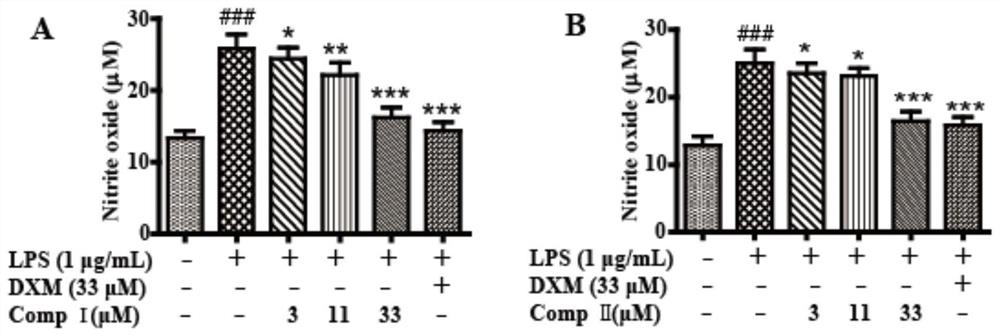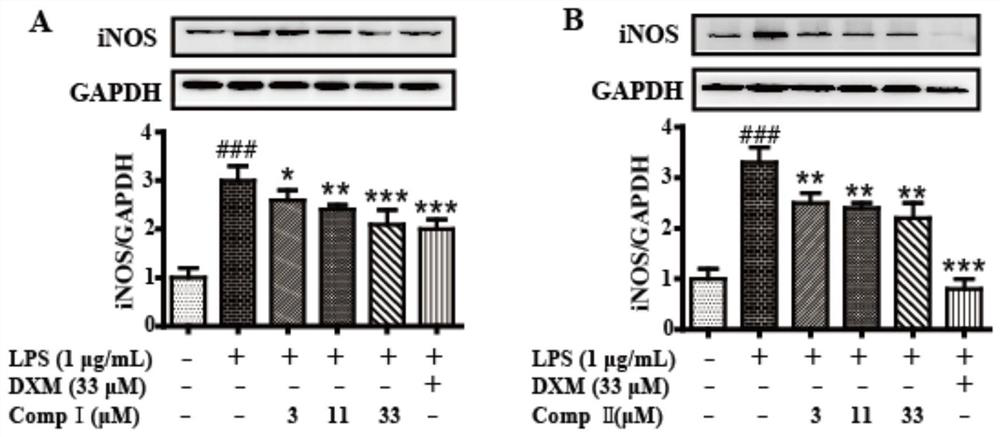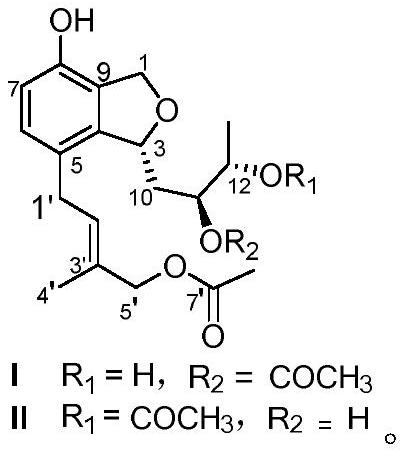Polyketone compound derived from sponge endophytic fungi and application of polyketone compound in preparation of anti-inflammatory drugs
A technology of endophytic fungi and compounds, applied in the field of pharmaceutical compounds, can solve problems such as injury, adverse reactions, liver damage, etc.
- Summary
- Abstract
- Description
- Claims
- Application Information
AI Technical Summary
Problems solved by technology
Method used
Image
Examples
Embodiment 1
[0023] The acquisition of embodiment 1 sponge endophytic fungus
[0024] 1. Experimental method
[0025] The inventor team isolated a sponge endophytic fungus from the brown flat sponge (Phakellia fusca) collected from the Xisha Islands in China, which was identified as Pestalotiopsis heterocornis by rDNAits region analysis.
[0026] 2. Experimental results
[0027] The ITS-rRNA gene sequence of the sponge endophytic fungus is shown in SEQ ID NO.1:
Embodiment 2
[0028] Preparation identification of embodiment 2 polyketides
[0029] In this example, polyketide derivatives were obtained by fermenting endophytic fungi in sponges. The specific experimental methods and results are as follows:
[0030] 2.1. Preparation of derivatives
[0031] The preparation method of derivative comprises the following steps:
[0032] (1) insert the fungus Pestalopipsisheterocornis isolated from the brown flat sponge into the seed culture medium to obtain the seed culture liquid; the components of the seed culture medium (by specific gravity): malt soak Paste 5-20g, coarse sea salt 10-20g, distilled water 1000-2000ml, pH 7.4-8.2;
[0033] (2) Fungal fermentation culture: insert the seed culture solution into the solid fermentation medium, and let it stand for cultivation; the composition of the solid rice fermentation culture: 100-200g of rice, 2-10g of coarse sea salt, 200-1000m of tap water, and the cultivation time : 28-60 days, static culture tempera...
Embodiment 3
[0049] Anti-inflammatory activity research of embodiment 3 polyketide compounds
[0050] 1. Cell culture and anti-inflammatory activity detection
[0051] (1) RAW264.7 cells were inoculated in 10% FBS DMEM high-glucose medium, and routinely cultured and passaged at 37°C and 5% carbon dioxide.
[0052] (2) Anti-inflammatory activity detection
[0053] RAW264.7 cells grown in logarithmic phase were taken at 1×10 6 Cells / well were seeded in 6-well plates. After 24 h, the cells were pretreated with compound Ⅰ (0, 3, 11, 33 μM), Ⅱ (0, 3, 11, 33 μM) and the positive drug dexamethasone DXM (33 μ M) for 2 h, and then LPS (1 μg / mL ) to stimulate the cells for 24h. The supernatant was collected and the NO content was detected by the Griess method. The result is as follows figure 1 As shown, both compounds Ⅰ and Ⅱ can significantly inhibit LPS-induced NO release from macrophages, and compounds Ⅰ and Ⅱ have no cytotoxicity, so it can be preliminarily concluded that compounds Ⅰ and Ⅱ...
PUM
 Login to View More
Login to View More Abstract
Description
Claims
Application Information
 Login to View More
Login to View More - R&D
- Intellectual Property
- Life Sciences
- Materials
- Tech Scout
- Unparalleled Data Quality
- Higher Quality Content
- 60% Fewer Hallucinations
Browse by: Latest US Patents, China's latest patents, Technical Efficacy Thesaurus, Application Domain, Technology Topic, Popular Technical Reports.
© 2025 PatSnap. All rights reserved.Legal|Privacy policy|Modern Slavery Act Transparency Statement|Sitemap|About US| Contact US: help@patsnap.com



